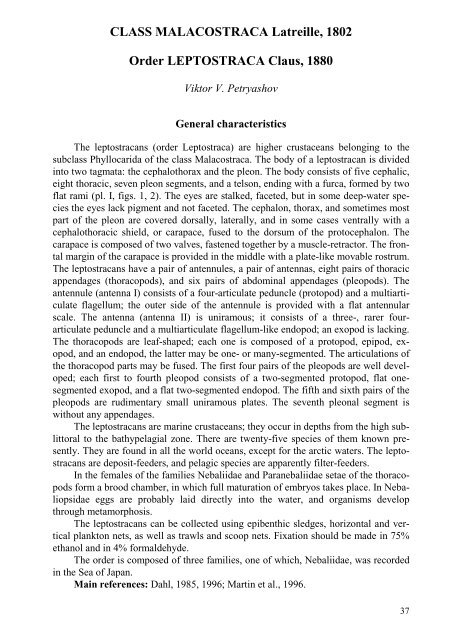биота российских вод японского моря - Materials of Alexey Shipunov
биота российских вод японского моря - Materials of Alexey Shipunov
биота российских вод японского моря - Materials of Alexey Shipunov
You also want an ePaper? Increase the reach of your titles
YUMPU automatically turns print PDFs into web optimized ePapers that Google loves.
CLASS MALACOSTRACA Latreille, 1802Order LEPTOSTRACA Claus, 1880Viktor V. PetryashovGeneral characteristicsThe leptostracans (order Leptostraca) are higher crustaceans belonging to thesubclass Phyllocarida <strong>of</strong> the class Malacostraca. The body <strong>of</strong> a leptostracan is dividedinto two tagmata: the cephalothorax and the pleon. The body consists <strong>of</strong> five cephalic,eight thoracic, seven pleon segments, and a telson, ending with a furca, formed by tw<strong>of</strong>lat rami (pl. I, figs. 1, 2). The eyes are stalked, faceted, but in some deep-water speciesthe eyes lack pigment and not faceted. The cephalon, thorax, and sometimes mostpart <strong>of</strong> the pleon are covered dorsally, laterally, and in some cases ventrally with acephalothoracic shield, or carapace, fused to the dorsum <strong>of</strong> the protocephalon. Thecarapace is composed <strong>of</strong> two valves, fastened together by a muscle-retractor. The frontalmargin <strong>of</strong> the carapace is provided in the middle with a plate-like movable rostrum.The leptostracans have a pair <strong>of</strong> antennules, a pair <strong>of</strong> antennas, eight pairs <strong>of</strong> thoracicappendages (thoracopods), and six pairs <strong>of</strong> abdominal appendages (pleopods). Theantennule (antenna I) consists <strong>of</strong> a four-articulate peduncle (protopod) and a multiarticulateflagellum; the outer side <strong>of</strong> the antennule is provided with a flat antennularscale. The antenna (antenna II) is uniramous; it consists <strong>of</strong> a three-, rarer fourarticulatepeduncle and a multiarticulate flagellum-like endopod; an exopod is lacking.The thoracopods are leaf-shaped; each one is composed <strong>of</strong> a protopod, epipod, exopod,and an endopod, the latter may be one- or many-segmented. The articulations <strong>of</strong>the thoracopod parts may be fused. The first four pairs <strong>of</strong> the pleopods are well developed;each first to fourth pleopod consists <strong>of</strong> a two-segmented protopod, flat onesegmentedexopod, and a flat two-segmented endopod. The fifth and sixth pairs <strong>of</strong> thepleopods are rudimentary small uniramous plates. The seventh pleonal segment iswithout any appendages.The leptostracans are marine crustaceans; they occur in depths from the high sublittoralto the bathypelagial zone. There are twenty-five species <strong>of</strong> them known presently.They are found in all the world oceans, except for the arctic waters. The leptostracansare deposit-feeders, and pelagic species are apparently filter-feeders.In the females <strong>of</strong> the families Nebaliidae and Paranebaliidae setae <strong>of</strong> the thoracopodsform a brood chamber, in which full maturation <strong>of</strong> embryos takes place. In Nebaliopsidaeeggs are probably laid directly into the water, and organisms developthrough metamorphosis.The leptostracans can be collected using epibenthic sledges, horizontal and verticalplankton nets, as well as trawls and scoop nets. Fixation should be made in 75%ethanol and in 4% formaldehyde.The order is composed <strong>of</strong> three families, one <strong>of</strong> which, Nebaliidae, was recordedin the Sea <strong>of</strong> Japan.Main references: Dahl, 1985, 1996; Martin et al., 1996.37












